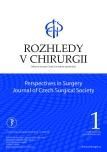Native nephrectomy in patients with autosomal dominant polycystic kidney disease in the kidney transplant program – single-center retrospective results of 2000−2020
Authors:
P. Navrátil 1,2,3; J. Špaček 1,3; M. Balík 1,3; I. Novák 1,2,3; J. Pacovsky 1,2,3; P. Navrátil st. 1,2,3; I. Guňka 2,3,4
Authors‘ workplace:
Urologická klinika, Fakultní nemocnice Hradec Králové
1; Mezioborové transplantační centrum Hradec Králové
2; Lékařská fakulta Univerzity Karlovy v Hradci Králové
3; Chirurgická klinika, Fakultní nemocnice Hradec Králové
4
Published in:
Rozhl. Chir., 2023, roč. 102, č. 1, s. 11-16.
Category:
Original articles
doi:
https://doi.org/10.33699/PIS.2023.102.1.11–16
Overview
Introduction: Autosomal dominant polycystic kidney disease (ADPKD) is a genetic disease that leads to chronic renal failure in about half of patients. It is a multisystemic disease with a predominance of kidney involvement, which significantly worsens the patient’s health. Controversial issues include the indication and the timing and technique of nephrectomy of native polycystic kidneys.
Methods: A retrospective observational study focused on the surgical aspects of patients with ADPKD who underwent native nephrectomy at our institution. The group included patients operated on in the period 1/1/2000–31/12/2020. A total of 115 patients with ADPKD were enrolled (14.7% of all transplant recipients). We evaluated the basic demographic data, type of surgery, indications and complications in this group.
Results: Native nephrectomy was performed in 68 out of a total of 115 (59%) patients. Unilateral nephrectomy was done in 22 (32%) patients and bilateral in 46 (68%). The most common indications were infections (42 patients, 36%), pain (31 patients, 27%), hematuria (14 patients, 12%), gastrointestinal reasons (1 patient, 1%), respiratory reasons (1 patient, 1%), obtaining a site for transplantation (17 patients, 15%) and suspected tumor (5 patients, 4%).
Conclusion: Native nephrectomy is recommended in symptomatic kidneys, or in asymptomatic kidneys when it is necessary to obtain a place for kidney transplantation, and in kidneys where a tumor is suspected.
Keywords:
kidney transplantation – ADPKD – autosomal dominant polycystic kidney disease – native nephrectomy
Sources
1. Levy M, Feingold J. Estimating prevalence in single-gene kidney diseases progressing to renal failure. Kidney Int. 2000;58(3)925–943. doi:10.1046/j.1523 - 1755.2000.00250.x.
2. Hateboer N, v Dijk MA, Bogdanova N, et al. Comparison of phenotypes of polycystic kidney disease types 1 and 2. Lancet 1999;353(9147):103–107. doi:10.1016/ S0140-6736(98)03495-3.
3. Dengu F, Azhar B, Pate S, et al. Bilateral nephrectomy for autosomal dominant polycystic kidney disease and timing of kidney transplant: A review of the technical advances in surgical management of autosomal dominant polycystic disease. Exp Clin Transplant. 2015;13(3):209–213. doi:10.6002/ect.2015.0104.
4. Bennett AH, Stewart W, Lazarus JM. Bilateral nephrectomy in patients with polycystic renal disease. Surg Gynecol Obstet. 1973;137(5):819–820. Available at: http://www.ncbi.nlm.nih.gov/ pubmed/4583527.
5. Mendelssohn DC, Harding ME, Cardella CJ, et al. Management of end-stage autosomal dominant polycystic kidney disease with hemodialysis and transplantation. Clin. Nephrol. 1988;30(6):315–319. Available at: www.ncbi.nlm.nih.gov/ pubmed/3072137.
6. Guo P, Xu W, Li H, et al. Laparoscopic nephrectomy versus open nephrectomy for patients with autosomal dominant polycystic kidney disease: A systematic review and meta-analysis. PLoS One 2015;10(6):e0129317. doi:10.1371/journal. pone.0129317.
7. Fuller TF, Brennan TV, Feng S, et al. End stage polycystic kidney disease: indications and timing of native nephrectomy relative to kidney transplantation. J Urol. 2005;174(6):2284–2268. doi:10.1097/01. ju.0000181208.06507.aa.
8. Rozanski J, Kozlowska I, Myslak M, et al. Pretransplant nephrectomy in patients with autosomal dominant polycystic kidney disease. Transplant Proc. 2005;37(2):666–668. doi:10.1016/j.transproceed. 2004.12.115.
9. P. Nunes, Mota A, Alves R, et al. Simultaneous renal transplantation and native nephrectomy in patients with autosomal-dominant polycystic kidney disease. Transplant Proc. 2007;39(8).2483–2485. doi:10.1016/j. transproceed.2007.07.035.
10. Wagner MD, Prather JC, Barry JM. Selective, concurrent bilateral nephrectomies at renal transplantation for autosomal dominant polycystic kidney disease. J Urol. 2007;177(6):2250–2254; discussion 2254, Jun. 2007. doi:10.1016/j. juro.2007.01.146.
11. D. Cohen, Timsit MO, Chrétien Y, et al. Place of nephrectomy in patients with autosomal dominant polycystic kidney disease waiting for renal transplantation. [Article in French] Prog Urol. 2008;18 : 642–649. doi:10.1016/j. purol.2008.06.004.
12. Glassman DT, Nipkow L, Bartlett ST, et al. Bilateral nephrectomy with concomitant renal graft transplantation for autosomal dominant polycystic kidney disease. J Urol. 2000;164(3)Pt 1 : 661–664. doi:10.1097/00005392-200009010 - 00011.
Labels
Surgery Orthopaedics Trauma surgeryArticle was published in
Perspectives in Surgery

2023 Issue 1
Most read in this issue
- Appendiceal tumors and pseudomyxoma peritonei: current recommendations for clinical practice
- Incidence of postoperative complications in patients with breast cancer depending on the type of drain
- Intrapulmonary sequestration with destructive pneumonia and life-threatening hemoptysis in an adult patient: a case report
- Case report Ileal diverticulitis with covered perforation complicated by pulmonary embolism – case report
